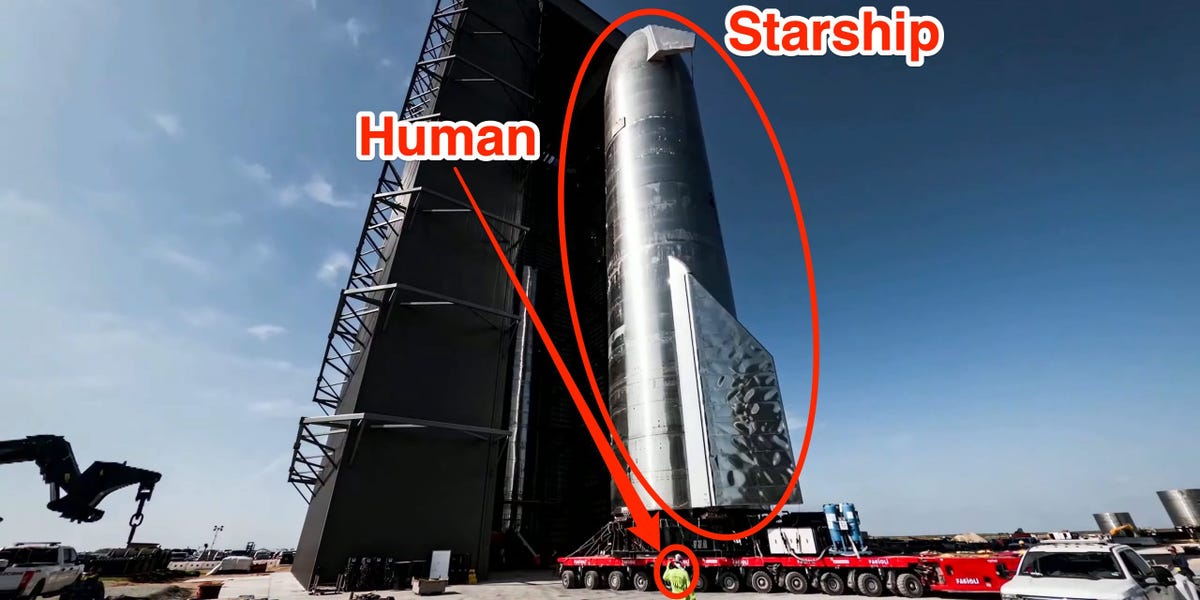SpaceX’s Starship rocket launched to space for the first time on Thursday. It’s a major milestone in SpaceX’s long list of technological achievements.
The Starship-Super Heavy system is the tallest and most powerful rocket ever built. It’s capable of producing more thrust upon liftoff than any other rocket in history, including NASA’s giant Space Launch System and the Saturn V that took astronauts to the moon.
SpaceX founder and CEO Elon Musk dreams of using Starship to establish a human colony on Mars as well as help NASA send astronauts back to the moon.
But just how big does a rocket need to be to carry people and cargo to the moon and Mars?
Pretty enormous, it turns out. The rocket has two stages: the Starship spacecraft itself up top, and Super Heavy, the launch booster below.
SpaceX
On its own, Starship stands 164 feet (50 meters) tall — roughly the same height as 16 African elephants stacked on top of each other — and has a diameter of 29.5 feet (9 meters).
It dwarfs the SpaceX employees in charge of shuttling it across SpaceX’s Starbase facility in Boca Chica, Texas.
Puny humans for scale
SpaceX via Elon Musk/Twitter
The Super Heavy booster clocks in at 226 feet (69 meters) — the same as a tower of about 23 African elephants.
Combined with Starship, it has a liftoff mass of 11 million pounds — about 5,000 metric tons. For comparison, the International Space Station has a mass of just under 1 million pounds.
SpaceX via YouTube
This immensely-powerful, reusable booster is designed to thrust Starship into orbit and then return to Earth for more launches. SpaceX has yet to attempt this feat, but its mostly-successful test flight on Thursday brings the company one step closer.
Musk has said it would take 1,000 Starship rockets to establish a sustainable base on Mars.
SpaceX vis YouTube
With Super Heavy’s reusable capacity, the company wouldn’t have to build 1,000 boosters to launch 1,000 Starships. Instead, it could shuttle one Starship after another, like an airport to space — a spaceport!
Even close up, humans look tiny compared to Starship and Super Heavy:
SpaceX vis YouTube
Zoom out a little and you can’t even see the humans anymore, just the giant cranes and launch- and catch-towers that use robotic arms to stack Starship on top of Super Heavy.
SpaceX via YouTube
And if this rocket didn’t look big enough already, Musk named the launch tower “Mechazilla,” most likely after the Mechagodzilla character in the Godzilla franchise.
The tallest rocket ever built
When stacked on top of each other, Starship and Super Heavy stand 394 feet tall. That’s nearly 100 feet taller than the Statue of Liberty and 31 feet taller than the Saturn V, the next-tallest rocket ever built.
Marianne Ayala/Insider
In total, the mega-rocket contains 39 engines: Super Heavy provides all the launch power upon liftoff, running on 33 truck-sized Raptor engines, which are capable of generating twice the power of NASA’s Artemis 1 — previously described as the most powerful rocket in history.
Making up the remaining six engines are Starship’s powerhouse, which consists of three Raptor engines and three even larger Raptor Vacuum engines. The RVac engines, shown on the right in the photo below, have a significantly larger nozzle and are specially designed for the space vacuum.
SpaceX via Twitter
The Starship mega-rocket’s successful flight to space is just the beginning.
Musk congratulated SpaceX on its next step toward fulfilling his dreams of settling Mars.




